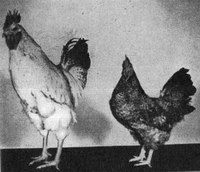Dwarfism in chickens
Dwarfism in Chickens is a condition characterized by the abnormal growth and development of chickens, resulting in significantly smaller stature compared to typical birds of the species. This condition can be caused by genetic, nutritional, or environmental factors, and it affects various aspects of the chicken's health, productivity, and overall well-being.
Causes[edit | edit source]
Dwarfism in chickens can be attributed to several factors, including:
- Genetics: Certain genetic mutations or hereditary conditions can lead to dwarfism. Breeds such as the Bantam are naturally smaller, but true dwarfism is a distinct condition that results from specific genetic anomalies.
- Nutrition: Inadequate nutrition, especially during the critical growth phases of a chicken's life, can result in stunted growth. Deficiencies in essential nutrients like proteins, vitamins, and minerals are common culprits.
- Disease and Infection: Certain diseases and infections can impair growth and development, leading to dwarfism. These include viral infections, parasitic infestations, and other health conditions that impact growth rates.
Symptoms[edit | edit source]
Symptoms of dwarfism in chickens may include, but are not limited to:
- Significantly smaller size compared to chickens of the same age and breed
- Proportional or disproportionate body parts
- Delayed or stunted feather growth
- Potential for increased susceptibility to illness and disease due to compromised immune system
Diagnosis[edit | edit source]
Diagnosis of dwarfism in chickens involves a combination of physical examination, review of the chicken's growth history, and genetic testing to identify any underlying genetic causes. Nutritional assessments and evaluations for possible infections or diseases may also be conducted to determine the cause of the dwarfism.
Treatment[edit | edit source]
Treatment for dwarfism in chickens depends on the underlying cause:
- For genetic causes, there is no cure, but supportive care can help manage the condition.
- Nutritional dwarfism can often be corrected or improved through dietary modifications and supplementation.
- If disease or infection is the cause, appropriate medical treatment can address the underlying condition, potentially allowing for resumed growth if permanent damage has not occurred.
Management[edit | edit source]
Managing dwarfism in chickens involves providing a supportive environment that caters to their specific needs. This may include:
- Ensuring easy access to food and water
- Providing a safe, stress-free environment to prevent injury and disease
- Regular health check-ups to monitor for any complications arising from the condition
Breeding Considerations[edit | edit source]
Breeding from chickens known to carry genes for dwarfism is generally discouraged to prevent passing the condition on to offspring. Responsible breeding practices involve genetic screening and selection to minimize the risk of dwarfism and other genetic conditions.
Conclusion[edit | edit source]
Dwarfism in chickens is a complex condition with various causes and implications for the affected birds. Understanding the underlying causes and implementing appropriate management and treatment strategies are crucial for ensuring the well-being of dwarf chickens.
Search WikiMD
Ad.Tired of being Overweight? Try W8MD's physician weight loss program.
Semaglutide (Ozempic / Wegovy and Tirzepatide (Mounjaro / Zepbound) available.
Advertise on WikiMD
|
WikiMD's Wellness Encyclopedia |
| Let Food Be Thy Medicine Medicine Thy Food - Hippocrates |
Translate this page: - East Asian
中文,
日本,
한국어,
South Asian
हिन्दी,
தமிழ்,
తెలుగు,
Urdu,
ಕನ್ನಡ,
Southeast Asian
Indonesian,
Vietnamese,
Thai,
မြန်မာဘာသာ,
বাংলা
European
español,
Deutsch,
français,
Greek,
português do Brasil,
polski,
română,
русский,
Nederlands,
norsk,
svenska,
suomi,
Italian
Middle Eastern & African
عربى,
Turkish,
Persian,
Hebrew,
Afrikaans,
isiZulu,
Kiswahili,
Other
Bulgarian,
Hungarian,
Czech,
Swedish,
മലയാളം,
मराठी,
ਪੰਜਾਬੀ,
ગુજરાતી,
Portuguese,
Ukrainian
Medical Disclaimer: WikiMD is not a substitute for professional medical advice. The information on WikiMD is provided as an information resource only, may be incorrect, outdated or misleading, and is not to be used or relied on for any diagnostic or treatment purposes. Please consult your health care provider before making any healthcare decisions or for guidance about a specific medical condition. WikiMD expressly disclaims responsibility, and shall have no liability, for any damages, loss, injury, or liability whatsoever suffered as a result of your reliance on the information contained in this site. By visiting this site you agree to the foregoing terms and conditions, which may from time to time be changed or supplemented by WikiMD. If you do not agree to the foregoing terms and conditions, you should not enter or use this site. See full disclaimer.
Credits:Most images are courtesy of Wikimedia commons, and templates, categories Wikipedia, licensed under CC BY SA or similar.
Contributors: Prab R. Tumpati, MD

